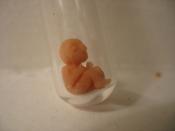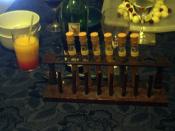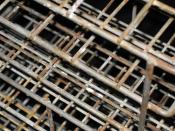Purpose: To investigate the effect of temperature on the fermentation of glucose by bakers yeast.
hypothesis
If to separate tubes of 20% glucose solution with 1 mil of yeast is added to battery jars filled with 20 and 38 c water then the warmer one will cause the yeast to ferment at a quicker rate.
Materials:
-2 test tubes (100 mm. Long x 11 mm. I.D.)
-2 ones-hole stoppers (size 00 w/3 mm. Hole)
-Glucose
-Bakers yeast suspension
-Balance
-Molding clay
-Submersible test tube racks
-Pins
-Masking tape
-wax pencil
10 ml. pipette w/pump
50ml. graduated cylinder
Dropping pipette
Ice
Stirring rods
Thermometer
Battery jars (2)
1. Prepare a 20% glucose solution by mixing 8 g. of glucose with 32 ml. water.
2. Prepare two water bathes, one at 15 degrees C and another at 38 degrees C using battery jars, ice, and warm water from the tap.
Be sure that the water baths are deep enough for your respirometers to be completely submerged.
3. Prepare a data chart that will allow you to record the number of bubbles you see per minute for ten total minutes.
4. Prepare the two respirometers as shown to the right. Using a 10 mL. pipette and pump, put 4 mL. of the 20% glucose solution into each test tube. Add 1 mL. of yeast suspension to each tube after stirring the suspension completely. Mix by gently batting the tube bottom with one forefinger while gripping the top of the test tube tightly with the thumb and forefinger of the opposite hand. Put a one-hole stopper on each test tube, being sure that it seals the tube. Stick a pin with a tape flag into the stopper to identify the tube as yours. Knead and stick a small amount of modeling clay...


